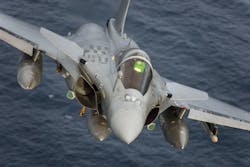Senseeker to develop technologies for longwave infrared focal plane arrays in aerial search and track
WRIGHT-PATTERSON AFB, Ohio – U.S. Air Force researchers needed a large-format longwave infrared digital pixel readout integrated circuit for future infrared search-and-track (IRST) sensors for combat aircraft. They found their solution from Senseeker Engineering Inc. in Santa Barbara, Calif.
Officials of the Air Force Research Laboratory at Wright-Patterson Air Force Base, Ohio, announced a $1.4 million contract to Senseeker on Monday for the Large Format High Dynamic Range LWIR Solution for Airborne IRST project.
The company will develop an advanced large-format high-dynamic-range long wave infrared (LWIR) digital pixel readout integrated circuit (DPROIC) for airborne IRST applications.
This project is part of the Air Force Research Lab's Multi-Spectral Sensing Technologies Research and Development (MUSTER) program to develop radio frequency and electro-optical sensors for offensive, defensive, and integrated offensive and defensive systems.
Senseeker will develop enabling technologies for Air Force Researchers that provide everything necessary for a 20-micron pixel pitch 2k-by-2k format digital pixel demonstration sensor system. Except for the LWIR detectors, these technologies will make the final IRST sensor focal plane array.
Senseeker will supply top-graded DPROIC dies, specialized test electronics, advanced imaging software, leadless chip carrier packages, and cryogenic test to accommodate the large-format infrared focal plane arrays.
Company engineers will create one demonstration system, and two finished systems for the Air Force. The company also will provide 20 top-grade dies; several lower-grade dies in wafer form; and wafer maps of die yield that are ready for a vendor to create focal plane arrays.
Related: Army night-vision researchers look to Raytheon to develop advanced IR focal plane arrays
Leading the MUSTER program are experts in the Sensors Directorate of the Air Force Research Lab's Multispectral Sensing and Detection Division.
MUSTER is sponsoring research not only in IRST enabling technologies, but also in antenna technologies and electromagnetic scattering; RF sensor systems; waveform phenomenology, design and applications; ultra-sensitive receivers for signals intelligence; standoff high resolution imaging; passive infrared space-based sensing; laser radar (ladar) imaging, systems, components, and applications; sensor information processing and integration; adaptive radar; and advanced digital multifunction arrays.
For more information contact Senseeker Engineering online at https://senseeker.com; or the Air Force Research Laboratory at www.afrl.af.mil.
About the Author
John Keller
Editor-in-Chief
John Keller is the Editor-in-Chief, Military & Aerospace Electronics Magazine--provides extensive coverage and analysis of enabling electronics and optoelectronic technologies in military, space and commercial aviation applications. John has been a member of the Military & Aerospace Electronics staff since 1989 and chief editor since 1995.
